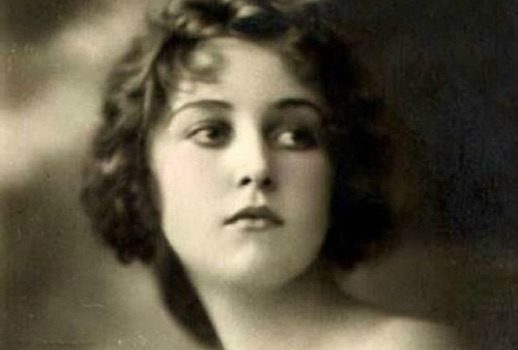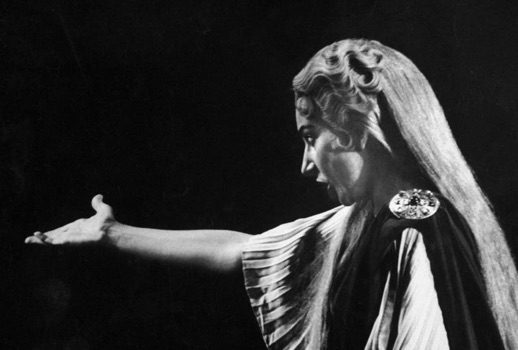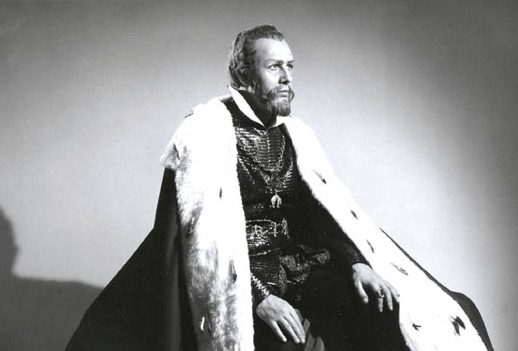

Tristan has been the season-launching opera three times before now, but good luck finding someone to provide a firsthand account of the last time. Stemme and Skelton will follow in the footsteps of Flagstad and Melchior (1937), who followed Ternina and Van Dyck (1901), who followed Lehmann and Niemann (1887).
Of these three illustrious pairings, that of Kirsten Flagstad and Lauritz Melchior is most familiar to us listeners of the 21st century. While Stemme and Skelton will be singing their roles at the Met for the first time, the Scandinavian Connection headlined 67 Met Tristans between 1935 and 1941, both at 39th and Broadway and on tour. The 1937 opening night was the 26th of these. Artur Bodanzky‘s cast also included Kerstin Thorborg, Julius Huehn and Emanuel List.
How “ordinary” was a Flagstad/Melchior Tristan in those days? Reviewing one Saturday matinee of the late 1930s with all five of the above singers and the same conductor, the Herald Tribune took a cautioning note:
The frequenters of out foremost opera house are perhaps beginning to regard the accomplishments of Mme. Flagstad a bit too complacently, for while there was no want of enthusiasm in the reception accorded her, there were numerous vacant seats and the number of standees was considerably smaller that it has been in past seasons at Tristan performances in which she has participated. […] Such artistry is rare in any time, and in our day, when good singing–not to speak of great singing—is all too rarely encountered, it should not be too lightly appraised.
Here are Flagstad, Melchior and Bodanzky in the last performance of the 1937-38 season.
A review of the historical archive illuminates how the different regimes of different times had differing ideas about what an opening night should be. The incumbent general manager has favored new productions of familiar, popular works, and in one case the Met premiere of an opera many considered overdue (Anna Bolena, 2011). Only once has there been a gala, the 2008 Renée Fleming showcase.
Those productions have covered the spectrum from triumphant (Madama Butterfly) to dismal (Tosca) to just “there” (…actually, all of the others), but they have brought to opening night some excitement that had ebbed away in the Crawford/Southern/Volpe years. In that era, it usually seemed as though the previous season were picking up where it had left off, with a business-as-usual Aïda, Bohème or Carmen slapped onto the stage in an existing production that had worked or had not worked, plus one big star.
“But opera is about the singing!” you say. Yes, yes. In more distant times, opening night was often a time of important musical debuts. This is something of which we have not seen much in recent decades. In the Gelb era, there have been the slim pickings of Stephen Costello (2007) and Amanda Majeski (2014)… the former in a comprimario role, the latter as an emergency replacement. New faces to begin the season were few and far between in the 20 years prior to Gelb’s time too. José Cura had been highly touted in advance in 1999, but he was an anomaly.
As you will see below, in the Met’s first century, many significant artists were initially heard on opening night. There were so many such examples that I had to leave many out of my survey in the interests of brevity and balance: Geraldine Farrar, Emmy Destinn, Tullio Serafin, Fritz Busch, Erna Berger, George London, Giulietta Simionato, Bonaldo Giaiotti, Florence Quivar, Kurt Moll. In first-night casting, at least, the most recent regimes have been in agreement, sticking with the tried and true.
Here is just some of what you could have seen, and perhaps did see, on opening night through the years at the Met.

The opera was received with no small favor, but it will have to grow into deep public affection. It is not the kind of work to carry an audience by storm. There is too much thought in it.
This brain food may have proved indigestible to New Yorkers of the Gilded Age; the work did not grow into deep public affection. After five performances, it was not heard again at the Met. Of the cast members, several of them debuting artists, only tenor Andreas Dippel lasted past the 1890-91 season. He proved valuable in a wide range of repertoire over the following 18 years.
1893: For its tenth anniversary, the Met returned to the opera with which it had all begun, Gounod’s Faust. The entire previous season had been wiped out by an August 1892 fire, allegedly caused by a workman’s casually discarded cigarette. Recorded the Times:
There is scarcely a reminder of the old Metropolitan Opera House in the magnificent new building[,] a marvel of brightness in color and grace in all its outlines. The severe decorations of the auditorium, which was destroyed by the big fire, have given place to brighter ornamentation, and, while the seating capacity of the house has been materially increased, the comfort of its patrons has been steadily kept in view in the arrangement of the changes.
Surely, all thought of ornamentation and outlines was put to the side when Emma Eames and brothers Jean and Edouard de Reszke got their Goethe on.




[T]he work has none of the spectacular glories usually associated with the opening night. […] Traviata, as all of us know, affords no opportunity for big ensembles, for massed effects, for the combined assault of cumulative sonority and gorgeous pageantry upon eye and ear.”
One suspects this gifted writer would never have foreseen Meyerbeer’s fall from fashion. Still, Smith found excitement in the debut of soprano Amelita Galli-Curci.
[H]ow fascinating is Amelita’s impersonation of Violetta, already made familiar during her association with the visiting Chicago Opera Company! How imaginatively vivacious in the first act; how pathetic in the second; how tragic in the last. It was fitting, indeed, that [general manager] Giulio Gatti-Casazza should bring forward his latest “star” in Traviata. For surely no other role reveals her own peculiar powers, histrionic as well as vocal, to greater advantage; none permits her to disclose more affectingly the characteristic delicacy of her art, the essentially feminine charm of her persuasions.
Beniamino Gigli and De Luca supplied the masculine charm.


From a strictly realistic standpoint, it does not matter very much […] [T]he inaugural work could be almost any choice at all from the Metropolitan’s extensive repertoire, active or inactive. It might be Tristan or Mignon, Madama Butterfly or Dinorah–perhaps only Parsifal or In the Pasha’s Garden would not serve.
On this occasion, it was Otello. Giovanni Martinelli and Lawrence Tibbett returned to roles in which they were building legends, and Verdi’s score was in the hands of one of its great conductors, Ettore Panizza. Debuting soprano Maria Caniglia would not remain with the company for long, but her Desdemona made a strong impression:
[T]he Neapolitan soprano […] is a singing-actress of exceptional feeling and sincerity, a gracious and gentle personality, equipped with a sense of the theater and a voice which often serves her responsively as a vehicle of dramatic utterance and lyric speech. She was vocally ill at ease in the first two acts, but later she sang with greater freedom and security, and often with affecting beauty and communicative eloquence.
1950: The season and the eventful tenure of GM Rudolf Bing began with Verdi’s Don Carlo, featuring six notable debuts: sopranos Delia Rigal and Lucine Amara, mezzo Fedora Barbieri, bass Cesare Siepi, director Margaret Webster and designer Rolf Gérard. Jussi Björling, Robert Merrill and Jerome Hines completed the principal cast; Fritz Stiedry conducted. At this time, the opera itself could still be described as “Verdi’s gloomy and seldom-heard Don Carlo” (Max de Schauensee, Philadelphia Evening Bulletin). But Virgil Thomson was happy to see it back after a 27-year absence:
[T]his ever-so-grand grand opera is perfectly suited to the space and paraphernalia possibilities of New York’s historic music theater. It is also a fine vehicle for musical display, and last night’s performance was not wanting in grandeurs from the auditory wing.
He praised the sophisticated work of the director and designer.

The kind of voice, basically, requires some consideration. It is what every great artist’s means of communication becomes: an extension of her own personality. That personality is dynamic, highly charged, tigerish, and utterly under discipline. So, too, the voice is dynamically dramatic, produced as though it might be torn from the singer’s insides, and presided over with an almost visible concern for every word and note she sings. Nothing is thoughtless, left to chance, or without total purpose. Factually, Miss Callas cannot afford to perform otherwise, for were she dependent on the pure physical beauty of the sound she produces she would be sung out of sight by many people presently inconspicuous.”
Barbieri, Siepi and Mario del Monaco were this fabled Norma’s colleagues and competitors.

“New Yorkers at all levels have been talking, day and night, about quitting this city. It’s ‘so tired,’ ‘so sooty,’ ‘so traffic-choked,’ this ‘irritating island’ with its ‘horrid sights and sounds.’ Now, won’t these dear people please stay? There are new wonders here in New York and they’ve been wrought while the complainers were busy with pale martinis and dark moods.”


No one seemed very much interested in anyone else, and the drama dragged. If Miss Scotto’s technical execution was faulty, the others [Tatiana Troyanos, Plácido Domingo and Bonaldo Giaiotti] lacked delicacy, refinement—the individual touches, vocal and dramatic, by which imaginative singers bring Bellini’s opera to life. The approach of the conductor, James Levine, did not encourage them to finesse. He laid out foursquare metronomic rhythms. He was energetic and assured, […] but he showed almost no feeling for sensitive, flexible shaping of Bellini’s melodies.


Feasible, but on the whole so far from being satisfactory in both large and small matters that the success of the cycle may already be in jeopardy. Otto Schenk‘s staging is a schizoid affair, with naturalistic, 19th-century scenery bumping up against naturalistic acting in a 20th-century style. […] Günther Schneider-Siemssen‘s sets, which look as if they were copied from one of the historical dioramas in the Wagner museum at Bayreuth, are not individual in any way, but they please the eye and would serve well in a performance better directed and better sung.
Levine’s premiere cast included Jeannine Altmeyer, Hildegard Behrens, Brigitte Fassbaender, Peter Hofmann and Simon Estes.


a clean-lined, luxuriously spare Butterfly that borrows liberally from the traditions of Asian theater. Minghella is not the first director to try this, but no other director has accomplished his unaffected fusion of East and West with such sumptuous flair—abetted here by the sleek settings of Michael Levine and the elegant costumes by Han Feng—or his highly individual musicality.
Levine led Cristina Gallardo-Domas, Marcello Giordani, Maria Zifchak and Dwayne Croft. Sadly, this instant classic was both Minghella’s first opera production and his last. He died in 2008.
Reach your audience through parterre box!
parterre box, “the most essential blog in opera” (New York Times), is now booking display and sponsored content advertising for the 2023-2024 season. Join Carnegie Hall, Lincoln Center, Warner Classics and many others in reaching your target audience through parterre box.
parterre box, “the most essential blog in opera” (New York Times), is now booking display and sponsored content advertising for the 2023-2024 season. Join Carnegie Hall, Lincoln Center, Warner Classics and many others in reaching your target audience through parterre box.
-
Topics: amanda majeski, amelita galli-curci, anthony minghella, brigitte fassbaender, carlo bergonzi, cesare siepi, cristina gallardo-domas, dwayne croft, ekaterina gubanova, emma eames, enrico caruso, evgeny nikitin, ezio pinza, f. paul driscoll, fedora barbieri, florence quivar, franco zeffirelli, frieda hempel, giovanni martinelli, giuspeep, gunther schneider-siemssen, hildegard behrens, james levine, jeannine altmeyer, jessye norman, joseph volpe, jussi bjorling, kirsten flagstad, lauritz melchior, lawrence tibbett, lina cavalieri, luciano pavarotti, marcella sembrich, marcello giordani, margaret webster, maria callas, maria caniglia, mario del monaco, mariusz trelinski, martina arroyo, nina stemme, otto schenk, peter gelb, peter hofmann, placido domingo, renata scotto, rene pape, renee fleming, robert merrill, rosa ponselle, rudolf bing, sherrill milnes, simon estes, Simon Rattle, stephen costello, stuart skelton, tatiana troyanos, teresa stratas, the past, thomas schippers, tristan und isolde, week of tristan
Latest on Parterre
Merry Widow | Finger Lakes, NY | July 25-28
Geneva Light Opera’s production of Lehar’s The Merry Widow will feature prize-winning baritone Bryan Murray and soprano Alexis Olinyk in the superb acoustics of in the landmark Smith Opera House in Geneva, New York on July 25, 27, and 28. A small city on the north end of the largest of NY’s Finger Lakes, Geneva…
Geneva Light Opera’s production of Lehar’s The Merry Widow will feature prize-winning baritone Bryan Murray and soprano Alexis Olinyk in the superb acoustics of in the landmark Smith Opera House in Geneva, New York on July 25, 27, and 28. A small city on the north end of the largest of NY’s Finger Lakes, Geneva…
parterre in your box?
Get our free weekly newsletter delivered to your email.



























Comments